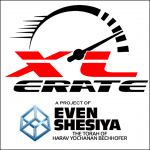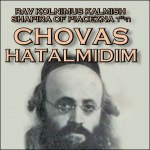Click here to download PDF
Mysterious Metaphor
In the opening Rashi to this week’s Parsha, Rashi tells us that after speaking concisely about Eisav’s descendants and how and where they settled, the Torah now turns to discuss Yaakov and his children at length and in great detail. Yaakov and his children are so important to Hashem and are worthy to speak of at length. Rashi adds that in a similar vein that by the 10 Generations from Adam until Noah it just says “so-and-so gave birth to so-and-so” and not more. When it comes to Noach it speaks about him at Great length. Similarly, the 10 Generations from Noach until Avraham Avinu are described very concisely. When the Torah comes to Avraham Avinu it talks about him at length and in detail. Rashi adds a metaphor “a pearl got lost in the sand. A man feels out the sand and sifts in a sifter until he finds the Pearl. Once he finds it he throws out all the Pebbles from his hands and takes the Pearl”.
Say What?
There is much that needs to be understood in this Rashi. It starts with a pearl lost in sand and sifting through sand and concludes with throwing away pebbles – What happened to the sand? The metaphor is unnecessary and totally incongruent to the topic at hand. The topic at hand is that the Torah only deems the Tzadik worthy to speak about at length and in detail and not the wicked. That idea is simple enough and straightforward and doesn’t require a metaphor at all! Why the metaphor? The metaphor is totally incongruous to our topic. The metaphor starts with a pearl getting lost. What “Pearl” got lost here? In the story line of the metaphor there is a necessity to sift through the sand to find the Pearl. We are talking about writing the Torah. There is no necessity for the author, Hashem, to mention the wicked at all! Hashem knows what he wants the write, He doesn’t have to sift through information, He just needs to write whatever he deems worthy of writing! What’s with the ‘sifting’?
Where it all started
The answer Lays and the very second Rashi in the Torah on the word “Beraishis” – in the beginning. Rashi says that it means “for the sake of the first” – for the sake of the Torah which is called “the first” and the sake of the Jewish people who are called “the first”. This is an amazing point to contemplate! The point of origin of all that exists branches out from the Torah and the concept of the Jewish people. That means that even things antithetical to Jews and Judaism somehow have their Origins in the Torah and the concept of the Jewish people! How could this be and why is it so?
Learn to Earn
The Ramchal teaches us that Hashem created the world with the agenda of bestowing goodness upon us. However to make us the rightful owners of that good and so it should be a part of our essence Hashem decreed that we have to earn it through hard work. Working and earning involves facing challenges. We must choose to do good no matter how hard that may be and reject what is wrong no matter how comfortable and pleasurable it looks. This program to toil and earn is rooted in the Divine plan that all branches out from, the point of “Beraishis” for the sake of the Torah and for the sake of the Jewish people. This means to say, that even the things that we struggle against in order to follow the dictates of the Torah were themselves created by the Torah. “Hashem looked into the Torah and created the world” applies to everything, not just the good, but even the things that we would call “bad”. Even what demands rejection is part of the cosmic formula for the ultimate goodness Hashem wants to bestow upon us.
What was Yaakov thinking?
With this we can understand another difficult Rashi. Rashi says”Yaakov sought to sit in tranquility but the turmoil (Rogez) of Yosef jumped upon him. Hashem says is it not enough for the Tzadikim that they have olam habah set up – they want to sit in tranquility in this world also?!” It can’t mean that Hashem wants us to have miserable lives in this world! A careful reading of Rashi shows that it’s not about pain and suffering – it’s about stress and tension. The term “Rogez” is all about tension like the Gemara says “L’olam Yargiz (root: Rogez) Adam Yetzer hatov al Yetzer hara – a man must always be in a state of tension and have his Yetzer hatov at odds with the Yetzer harah”. Life in this world is about tension. We’re supposed to be in a perpetual struggle between the inclination to do bad and the inclination to do good because that’s our job! We retire from our job to enjoy the fruits of our labors in Olam habah. Yaakov avinu perfected himself totally and therefore thought that he can have tranquility already in this world. The message is: so long as you’re living in this world you must look for more tension! Seek more things to contend with and fix! That is why the challenges of Yosef became “his problem” because he was no longer looking for problems to solve.
The Meta Program
Why did it have to be this way? Why the tension? Why was Man created with this “hang up” that makes him uncomfortable with getting something for free? The Ramchal answers (Daas Tevunos; Klach pischei Chochma) that there is actually a “meta program” that encompasses the “earn the Perfection program”. The “Meta program” is the real “first” (Beraishis) that encompasses the Torah and the Jewish people from which the rest of reality branched out from. Hashem wanted to reveal the “ultimate good” which is He Himself! What can we know about He who is infinite and defies any type of definition? The one thing we could know is that He is the one and only and nothing can compare to him. This will be fully revealed at the end of time when “Hashem will be One and His Name One”. Our mission as the chosen people is to attest to this idea (Rambam sefer HaMitzvos aseh 2) and hasten its revelation. It is our daily testimony in the Shema: Hashem is One!
Learning by Contrast
The Ramchal explains that Hashem being “the One and Only” could be comprehended by contrast. “One and only” is defined in the negative – nothing is real like Hashem or can compete with Hashem. Encountering any would-be competitor and figuring out for ourselves or alternatively having Hashem demonstrate to us that the competitor can’t stand up to Him reveals Hashem’s “Oneness” (=uniqueness). With the negation of all “others” it becomes clear that Hashem is “the one and only”. Since Hashem chose this program, it was necessary for Hashem to create ‘competitors’ for Himself and eventually to negate them to clarify that he is “the one and only”! Since the would-be competitors are temporarily around, for now, the Jewish people can play a role! To overcome the temptation from the ‘competitors’ and choose Hashem as reality itself! This encompasses the job to earn our keep and also plays a role in accelerating the revelation of Hashem being one and only.
The Place for the wicked in the Torah
Now we can understand why the wicked are even mentioned in the Torah. The wicked perform a very valuable function in Hashem’s plan for Destiny. “Sparks from the Torah” sustain them! They are here to challenge us and it is by Divine plan that we are challenged. The Divine plan is the Torah and “Sparks from the Torah” sustain them and enables them to do whatever they do. When we stand up to them and defeat them physically/spiritually, the “Sparks” that were sustaining them get removed from them and annexed to the Jewish people! The Chiddushei Torah that we invented in response to them such as the megillah and maseches Megilla in response to the challenge of Haman, Ner Chanukah and all the laws of Chanukah in response to our challenges from the Hellenists are actually the Sparks that we raised from them and are added on to the body of our Torah! In Hebrew, the word for sifting and the word for clarifying are the same word, Birur! What is clarification if not to sift out the truth from the confusion and throw all the falsehood away!
The Pearl and the Sand
Now we can understand Rashi’s metaphor. There are “Pearls” that “got lost”! The Pearls are from “Beraishis”, The Divine plan which is for the sake of the Torah and for the sake of the Jewish people. Sparks from it “got lost”. Those Sparks are in the Gentiles and everything else in the world that is not Torah or the Jewish people. Through the course of generations we are sifting through ‘Chol’ – Sand where there are some Sparks of the pearl. When we find the Pearls we throw the Pebbles away. Until we find the “pearls” they are hidden in ‘chol’ – sand. The Hebrew word for sand, ‘Chol’, is the same word for everything that isn’t holy. Rashi starts starts with sifting through the ‘Chol’ – sand the whole regular, secular, non- holy world. After sifting you throw away the Pebbles and keep the Pearl. Through the “sifting” we bring out (=clarify) the sparks of the “Pearl” that are hidden in the “Chol’ – the non-holy. When the non-holy is totally stripped of the Sparks of Holiness it’s not sand (Chol) any more – it’s pebbles (=Tzroros)! The Hebrew word for Pebbles is “Tzroros” which comes from the root “Tzar” which means narrowness and/or painful that has to be discarded. Once the “Sand” – the regular world- is stripped of the sparks of “pearl” it degenerates to useless pebbles.
8 Days and 36 lights
The word “Chol” could be broken up to the letter “Ches” which has the numerical value of eight and the letters “Lamed” and “Vav” which have the numerical value of thirty six. This alludes to the 8 days of Chanukah and the 36 candles that we light in course of the 8 days (1+2+3+4+5+6+7+8=36). The Greeks developed the secular (Chol -non holy) world. There are definitely positive elements hidden (=lost) in their sciences and culture. During the days of Chanukah the light of Torah shines and collects all the Sparks of Holiness that are lost there. As we sift out all the good from their world, Greek culture becomes an absolute Darkness, as Chazal say “Darkness (at the genesis) refers to Greece”. Left with no sparks of light in it, secular culture is totally dispelled by the absolute light of Torah.
Good Shabbos.











